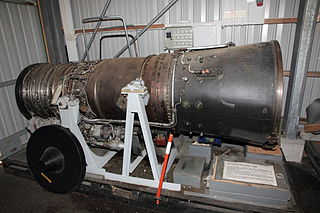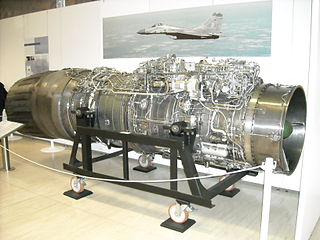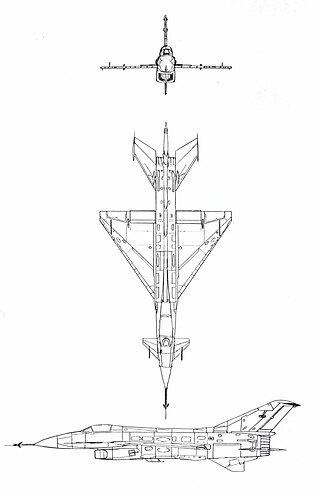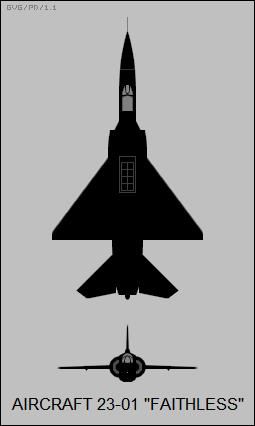
The Lyulka AL-21 is an axial flow turbojet engine created by the Soviet Design Bureau named for its chief designer Arkhip Lyulka.

The General Electric/Allison J35 was the United States Air Force's first axial-flow compressor jet engine. Originally developed by General Electric in parallel with the Whittle-based centrifugal-flow J33, the J35 was a fairly simple turbojet, consisting of an eleven-stage axial-flow compressor and a single-stage turbine. With the afterburner, which most models carried, it produced a thrust of 7,400 lbf (33 kN).

The Snecma Atar is a French axial-flow turbojet engine built by Snecma. It was derived from the German World War II BMW 018 design, and developed by ex-BMW engineers through a progression of more powerful models. The name is derived from its original design group, Atelier technique aéronautique de Rickenbach near Lindau within the French Occupation Zone of Germany. The Atar powered many of the French post-war jet aircraft, including the Vautour, Étendard and Super Étendard, Super Mystère and several models of the Mirage.

The General Electric J85 is a small single-shaft turbojet engine. Military versions produce up to 2,950 lbf (13.1 kN) of thrust dry; afterburning variants can reach up to 5,000 lbf (22 kN). The engine, depending upon additional equipment and specific model, weighs from 300 to 500 pounds. It is one of GE's most successful and longest in service military jet engines, with the civilian versions having logged over 16.5 million hours of operation. The United States Air Force plans to continue using the J85 in aircraft through 2040. Civilian models, known as the CJ610, are similar but supplied without an afterburner and are identical to non-afterburning J85 variants, while the CF700 adds a rear-mounted fan for improved fuel economy.

The Tumansky R-11 is a Soviet Cold War-era turbojet engine.

The Tumansky R-13 is a Soviet turbojet engine designed by Sergei Alekseevich Gavrilov.

The Tumansky R-25 is a turbojet engine, which is seen as the ultimate development of Tumansky R-11. It was designed under the leadership of Sergei Alekseevich Gavrilov.

The Lyulka AL-7 was a turbojet designed by Arkhip Mikhailovich Lyulka and produced by his Lyulka design bureau. The engine was produced between 1954 and 1970.

The Tumansky RD-9 was an early Soviet turbojet engine, not based on pre-existing German or British designs. The AM-5, developed by scaling down the AM-3, was available in 1952 and completed testing in 1953; it produced 25.5 kN (5,700 lbf) thrust without afterburner. The AM-5 engine is notable for making possible the first mass-produced supersonic interceptors such as the MiG-19, and the first Soviet all-weather area interceptor, the Yak-25. When Sergei Tumansky replaced Alexander Mikulin as the OKB-24's chief designer in 1956, the engine was renamed RD-9. The engine was later built under license in China as the WP-6.

The Tumansky R-15 is an axial flow, single shaft turbojet with an afterburner. Its best known use is on the Mikoyan-Gurevich MiG-25.

The Klimov RD-33 is a turbofan jet engine for a lightweight fighter jet and which is the primary engine for the Mikoyan MiG-29 and CAC/PAC JF-17 Thunder. It was developed in OKB-117 led by S. P. Izotov from 1968 with production starting in 1981. Previous generations of Russian supersonic fighters such as the MiG-21 and MiG-23 used turbojets, but western fighters such as the F-111 and F-4K introduced the use of afterburning turbofans in the 1960s which were more efficient.

The Saturn AL-31 is a family of axial flow turbofan engines, developed by the Lyulka design bureau in the Soviet Union, now NPO Saturn in Russia, originally as a 12.5-tonne powerplant for the Sukhoi Su-27 long range air superiority fighter. The AL-31 currently powers the Su-27 family of combat aircraft and some variants of the Chengdu J-10 multirole jet fighter. Assembly of the engine is also performed under license in India by HAL, for the Sukhoi Su-30MKI. Improved variants power the fifth-generation Sukhoi Su-57 and Chengdu J-20.

The General Electric YJ93 turbojet engine was designed as the powerplant for both the North American XB-70 Valkyrie bomber and the North American XF-108 Rapier interceptor. The YJ93 was a single-shaft axial-flow turbojet with a variable-stator compressor and a fully variable convergent/divergent exhaust nozzle. The maximum sea-level thrust was 28,800 lbf (128 kN).

The General Electric J73 turbojet was developed by General Electric from the earlier J47 engine. Its original USAF designation was J47-21, but with innovative features including variable inlet guide vanes, double-shell combustor case, and 50% greater airflow was redesignated J73. Its only operational use was in the North American F-86H.

The Mikoyan-Gurevich Ye-8 was a supersonic jet fighter developed in the Soviet Union, intended to replace the MiG-21. Only two prototypes were built in 1960–61. The original MiG-21's air intakes were moved under the fuselage, freeing up the nose where a larger and more powerful radar, able to deliver longer range air-to-air missiles, could be built in. Canards were built to both sides of the nose, in front of the cockpit,.
The Lyulka TR-1 was a turbojet designed by Arkhip Lyulka and produced by his Lyulka design bureau. It was the first indigenous Soviet jet engine.

The Turbomeca Gabizo was a small turbojet engine produced by Turbomeca from the 1950s. The components were designed to take the stresses of high-speed fighter aircraft with some variants featuring afterburner.
The Tumansky R-21 was a Soviet turbojet engine of the 1960s. Used for development only, the project was canceled.

The Mikulin AM-3 was a turbojet engine developed in the Soviet Union by Alexander Mikulin.

The Mikoyan-Gurevich 23-01, aka Izdeliye 92 and (erroneously) Mikoyan-Gurevich MiG-23PD, NATO reporting name Faithless, was a 1960s STOL fighter / attack aircraft, designed in the USSR, to fulfil a requirement for ground-attack and fighter aircraft able to operate from short runways.


















